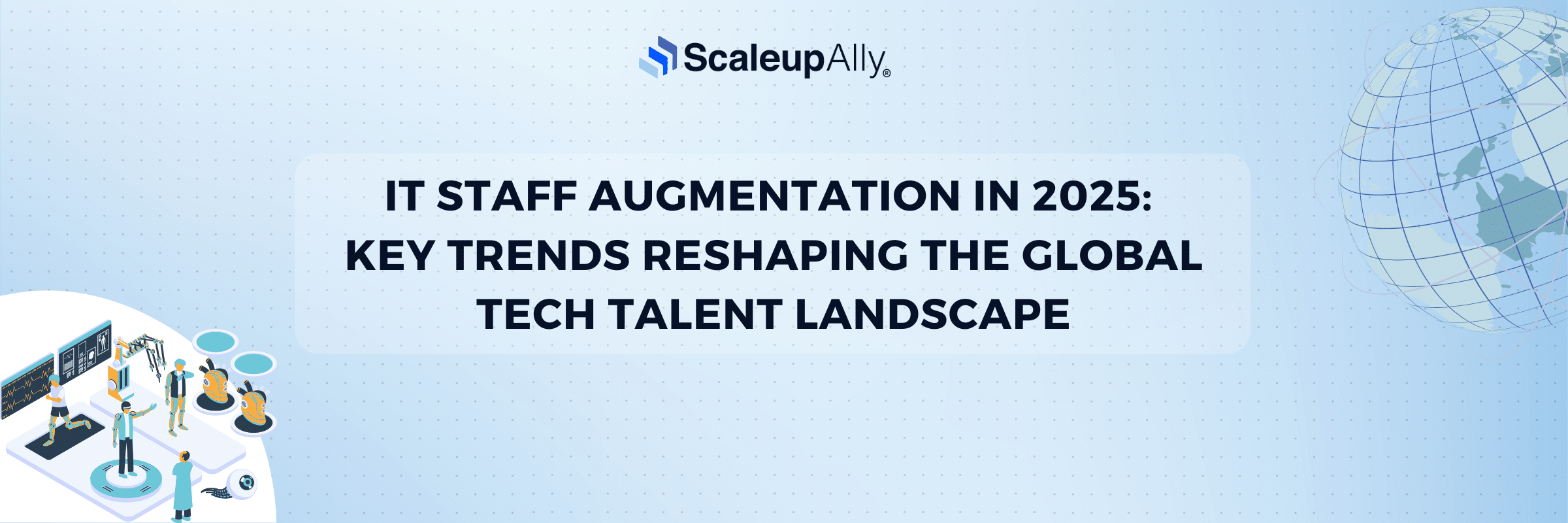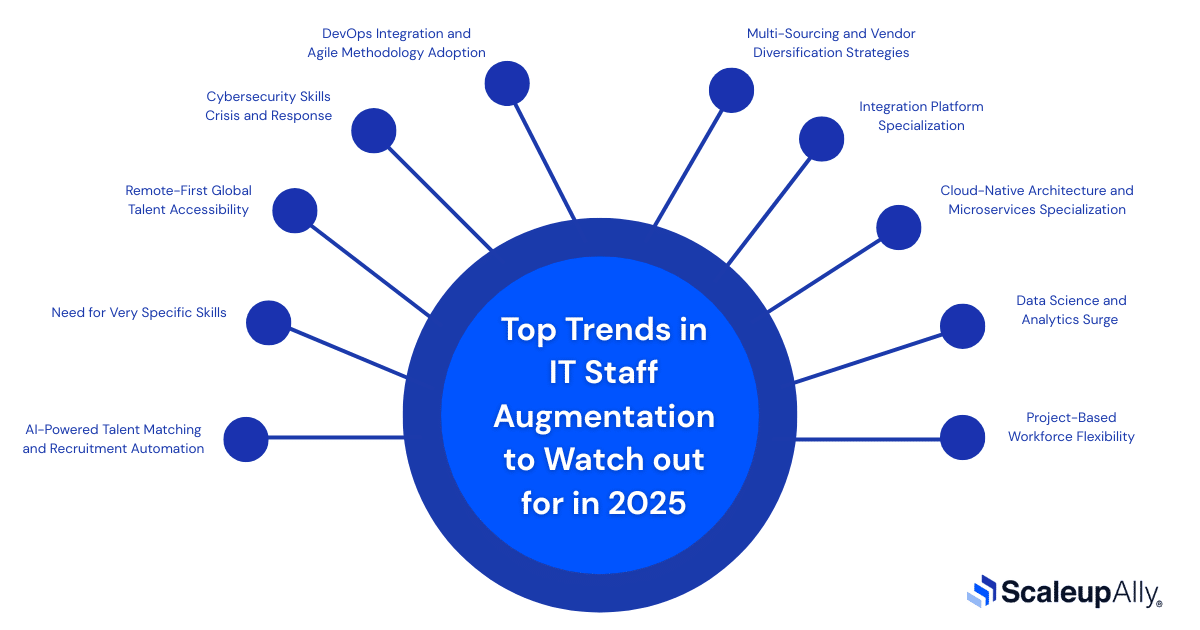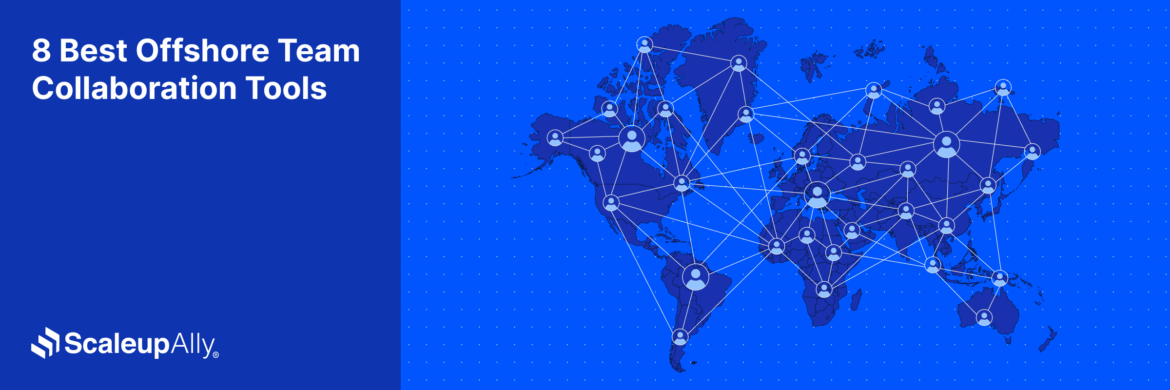
IT Staff Augmentation in 2025: Key Trends Reshaping the Global Tech Talent Landscape
Pranay Agrawal | June 28, 2025 , 10 min read
Table Of Content
The IT staff augmentation market is expected to grow from $299.3 billion in 2023 to a projected $857.2 billion by 2031. This expansion is expected to achieve a 13.2% compound annual growth rate. A clear sign that traditional hiring models are becoming obsolete.
At the core of this shift is a mounting talent crisis. Companies are struggling to fill 4 million software developer positions at the moment, and these vacancies are expected to remain vacant for the entirety of 2025. That is 1.4 million more than just four years ago. Why? The old playbook of posting jobs, interviewing candidates, and hoping for the best has become outdated.
76% of companies are already drowning in talent shortages, with 96.4% of tech firms struggling specifically with skills gaps. These are cracks in a system that can no longer keep pace with technological acceleration.
The IT staff augmentation trends emerging in 2025 reveal that businesses have stopped asking “Can we find the right people?” and started asking “How quickly can we access them?” The difference between those questions represents billions in lost revenue, delayed projects, and competitive disadvantage.
The challenge is global. Denmark anticipates a 13,500 engineer shortfall in 2025. Norway also anticipates 10,000 missing professionals. The United States faces a looming 1.2 million talent shortfall by 2026. These are based on current graduation rates and industry demand.
And yet some companies are thriving. How? They’ve cracked a code that others are still trying to decipher. The ability to scale talent as fluidly as they scale infrastructure. They’ve realized that in a world where technical skills have shrinking half-lives, ownership of talent matters less than access to it.
What makes 2025 different from previous years is the sophistication of solutions. The crude outsourcing models of the past have evolved.
The stakes have never been higher, and the solutions have never been more elegant. Welcome to the future of work, where geography is irrelevant, skills are preferred over titles, and the best teams aren’t built in conference rooms but assembled across continents.
This is your roadmap to that future.
Key Takeaways
- 4 million software developer positions will remain vacant by 2025, with 76% of companies already struggling to find skilled IT professionals
- The market has grown from $299 billion to a projected $857 billion by 2031 because companies can’t wait months to hire permanent staff
- Companies need hyper-specific skills like blockchain developers, cybersecurity experts, and DevOps engineers that are too rare and expensive to hire full-time
- Remote work has opened up global talent pools, letting companies assemble teams across continents instead of being limited to local hiring
- Businesses are organizing around specific projects rather than permanent positions, making flexible staff augmentation perfect for scaling teams up and down as needed
Top Trends in IT Staff Augmentation to Watch out for in 2025

The IT staff augmentation trends 2025 landscape is dynamic. These are trends that will determine which companies thrive and which become cautionary tales in business school case studies.
1. AI-Powered Talent Matching and Recruitment Automation
The days of recruiters matching resumes and job descriptions are over. AI has crashed the party. 69% of organizations are actively hiring employees with AI-related skills in 2025, while recruitment algorithms now analyze everything from coding patterns to communication styles to predict project success rates. These algorithms understand context and can even identify skill gaps ahead of time. This trend will shrink hiring cycles from months to weeks.
2. Need for Very Specific Skills
Today’s market needs niche specialists. The blockchain market is expected to hit $39.7 billion by 2025. This has created demand for developers who understand distributed ledgers and smart contracts.
Companies are hunting for experts in quantum computing, edge AI, neuromorphic chips, and technologies that didn’t exist five years ago. This hyperspecialization means traditional hiring is no longer useful. Staff augmentation has become the only viable way to access these rare skill sets without breaking the bank on permanent hires.
3. Remote-First Global Talent Accessibility
Physical borders have become irrelevant in modern business. 32.6 million Americans will be working remotely by 2025, but that’s just scratching the surface. Companies are now assembling teams that span continents with the same ease they once hired across town.
40% of jobs now allow some amount of remote work, fundamentally shifting how businesses think about talent acquisition. The best programmer for your project might be in Bucharest, your ideal UX designer in Buenos Aires, and your perfect DevOps engineer in Bangalore. Geography has stopped being a constraint and started being an opportunity.
4. Cybersecurity Skills Crisis and Response
51% of companies plan to hire full-time cybersecurity teams during 2025, yet 58% of organizations say skills gaps put them at significant risk. That math doesn’t add up, which is precisely why staff augmentation has become cybersecurity’s lifeline.
With IT managers stressed about remote work vulnerabilities, companies can’t afford to leave security positions vacant while searching for unicorn candidates. Staff augmentation provides immediate access to penetration testers, threat analysts, and compliance experts who can plug critical gaps while permanent hiring processes crawl forward.
5. DevOps Integration and Agile Methodology Adoption
85% of IT professionals will have fully adopted DevOps by 2025, according to Gartner. Finding professionals who think in continuous deployment cycles is a major trend in 2025.
DevOps engineers are practically extinct in the wild. Companies need specialists who can bridge development and operations seamlessly, professionals skilled in containerization, infrastructure as code, and cloud-native architectures. The traditional hiring timeline simply can’t keep pace with DevOps implementation needs.
6. Multi-Sourcing and Vendor Diversification Strategies
Smart companies have learned that putting all their talent eggs in one geographical basket is not sound. The multi-sourcing method spreads risk across regions, time zones, and economic conditions while tapping into diverse skill pools.
When 78% of businesses report positive experiences with their outsourcing providers, it cites better project outcomes and faster delivery times. This is creating resilient talent ecosystems that can weather disruptions, whether they’re pandemic-related, geopolitical, or economic.
7. Integration Platform Specialization
As companies adopt increasingly complex technology stacks, the need for integration specialists has become critical. These professionals understand how to make disparate systems communicate effectively, whether through APIs, middleware, or custom integration platforms.
Integration specialists ask for high salaries because their skills directly impact business continuity. For example, when systems don’t integrate, revenue stops flowing. Staff augmentation provides immediate access to these specialists when integration projects arise, without the long-term commitment of permanent hires.
8. Cloud-Native Architecture and Microservices Specialization
Cloud computing is reimagining entire application architectures. Companies need specialists who don’t just lift and shift existing applications but redesign them for cloud-native environments from the ground up.
The demand for professionals skilled in Kubernetes orchestration, serverless computing, and microservices architecture has exploded. These are skills that require deep expertise that companies can access immediately through staff augmentation rather than spending months training existing staff.
9. Data Science and Analytics Surge
Every company claims to be “data-driven,” but most are drowning in information while thirsting for insights. The explosion in data science roles isn’t just about big data anymore, but finding professionals who can extract actionable intelligence from noise.
Machine learning engineers, data architects, and analytics specialists command premium salaries and have their pick of opportunities. Staff augmentation provides companies access to these high-demand professionals for specific projects, allowing them to unlock data value without competing in the permanent hiring market.
10. Project-Based Workforce Flexibility
The traditional employment model is fracturing. Companies increasingly organize work around projects rather than permanent positions, requiring teams that can assemble quickly, execute brilliantly, and dissolve seamlessly when objectives are met.
This shift toward project-based work perfectly aligns with staff augmentation strengths. Instead of maintaining large permanent teams during slow periods or scrambling to hire during busy ones, companies can scale their workforce dynamically based on actual project requirements.
Conclusion
The IT staff augmentation trends we’ve explored aren’t distant possibilities. They’re happening right now, reshaping competitive landscapes while you read this sentence. Companies that hesitate are watching their agile competitors sprint past them with teams assembled from the world’s best talent pools.
What is the future of staff augmentation? It’s not just about filling gaps anymore. It’s about building elastic organizations that can expand and contract with market demands, access cutting-edge expertise on demand, and turn talent scarcity into an advantage.
But understanding these trends means nothing without execution. While you’re debating whether to embrace staff augmentation, your competitors are already scaling their blockchain teams, deploying AI specialists, and launching products faster than you thought possible.
The skills shortage isn’t going away. The World Economic Forum predicts that 50% of all employees will need reskilling by 2025, yet traditional hiring can’t keep pace with technological evolution. Staff augmentation has evolved from a nice-to-have backup plan into a mission-critical infrastructure for survival.
Every day you delay is another day your competition gains ground. The $857 billion staff augmentation market isn’t growing because it’s trendy, but it’s exploding because it works. Companies that master these trends will dominate their industries. Those that don’t will become case studies in business school textbooks about what happens when organizations fail to adapt.
Our team has helped hundreds of companies navigate these exact challenges, building world-class teams that deliver results while you focus on strategy. We provide talent solutions that scale with your ambitions.
Contact us today and discover how the right staff augmentation partner can transform your biggest challenge into your greatest competitive advantage. The future of work is here.
Don’t let talent shortages dictate your company’s limits. Let’s build something extraordinary together.
Frequently Asked Questions
Q: What is IT staff augmentation and how does it work?
IT staff augmentation lets companies hire skilled tech professionals temporarily to join their existing teams. Instead of lengthy permanent hiring, businesses access specialized talent for specific projects and continue to maintain control while filling skill gaps quickly and cost-effectively.
Q: What is the future of staff augmentation?
The future is AI-powered talent matching, global remote teams, and project-based work becoming the norm. Companies will treat talent like cloud resources by scaling up and down instantly based on needs, and accessing specialized skills worldwide without geographical limitations.
Q: Why do companies prefer IT staff augmentation?
Companies choose staff augmentation because it’s faster, cheaper, and more flexible than permanent hiring. They get immediate access to specialized skills, avoid recruitment costs and employee benefits, and can scale teams based on project demands without long-term commitments.
Q: What industries are benefiting most from IT staff augmentation?
Healthcare, banking, retail, and telecommunications lead adoption. These industries need rapid digital transformation, face severe talent shortages, require specialized skills like cybersecurity and AI, and must scale teams quickly for technology projects and regulatory compliance requirements.
Related Blogs

Calculating ROI for Software Development: A Detailed Guide
Discover proven strategies and practical tips to enhance the ROI for software development projects. Learn how to measure success and increase profitability.
Manu Jain
Nov 25 ,
19 min read

Offshore Team Collaboration Tools: 8 Picks That Keep Teams in Sync
Explore 8 top offshore team collaboration tools that keep global teams aligned across time zones. Compare features, async vs. sync strengths to streamline remote workflows.
Pranay Agrawal
Oct 29 ,
10 min read

Offshore Staff Augmentation: Benefits, Models & Challenges
Explore offshore staff augmentation in 2025—key benefits, models, challenges & when to use it. A complete guide for scaling your tech team.
Pranay Agrawal
Apr 26 ,
15 min read


